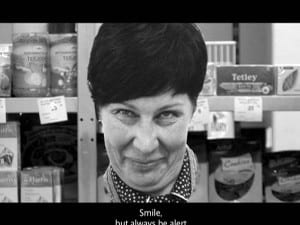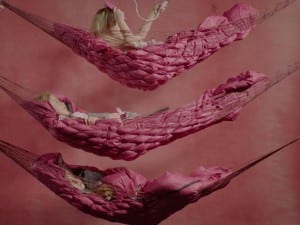A selection of 19 international artists working across a range of media trace the contours of the human body in Body Language at the Saatchi Gallery until 16 March. Exploring how working with the body in art reflects on the human form, this show spans the grotesque to the uncanny, the poignant to the satirical, across ages, genres and countries.
Body Language provides compelling evidence of the human body’s continued ability to articulate something historically specific and socially and politically important. One of the key artists of the collection, Jansson Stegner adopts tropes of Romanticism to portray contemporary longing, as female police officers crouch on rocks and tree stumps, batons substituted for parasols in their hands, trading their usual authoritative glance for a classical erotic innocence.
New York artist Dana Schutz’s paintings tread the line between form and chaos, creating visual narratives crammed with characters, props and activity and frenziedly incoherent. Makiko Kudo also showcases troubled melancholic characters trying to escape the woes of 20th century Japan. The work creates fictive worlds reminiscent of Manga comics, gesturing towards Monet’s Water Lillies and Matisse’s Fauvist work. Denis Tarasov, meanwhile, photographs Russian and Ukrainian mobster tombstones, relics of the 1990s Mafia Wars, which intricately depict the deceased body.
Also featured in Body Language is art from Tanyth Berkeley, Amy Bessone, Michael Cline, Nicole Eisenman, Chantal Joffe, Nathan Mabry, Eddie Martinez, Justin Matherly, Henry Taylor, Denis Tarasov, Alexander Tinei, Francis Upritchard, Andra Ursuta, Helen Verhoeven, Marianne Vitale, all demonstrating how the human body can be seen as visual art’s best metaphor for the experience of being alive.
Body Language, until 16 March, Saatchi Gallery, Duke of York’s HQ, King’s Road, London, SW3 4RY.
Credits
1. Marianne Vitale, Installation shot- Markers, 2011, Reclaimed lumber.





